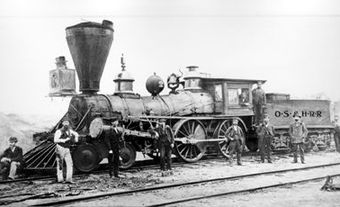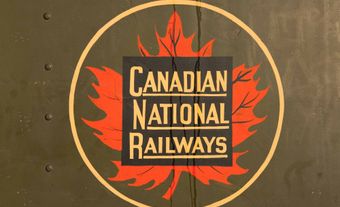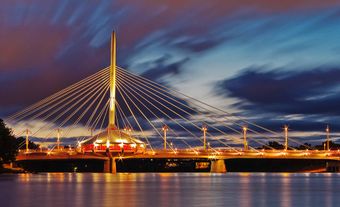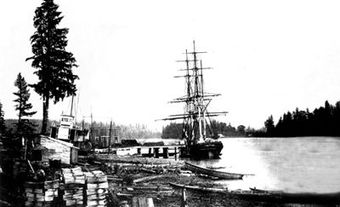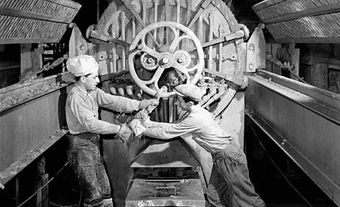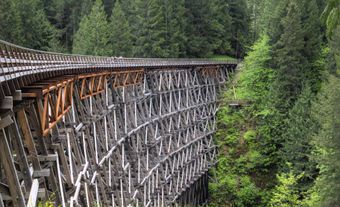The idea of the Hudson Bay Railway, which eventually came to run from Winnipeg to The Pas, and then to Churchill, Manitoba, was conceived by public and private interests in the late 19th century as a means of transporting grain as quickly as possible onto ships for overseas sale. Over a period of almost 50 years, construction efforts ran into various problems — including engineering disputes, storms, a harsh northern climate, fires, labour unrest, and material and labour shortages. From 1910 onwards, the federal government took charge of paying for the engineering and construction work for the railway line, particularly after the creation of Canadian National Railways in 1919. The line was completed in 1929 and opened for full service in 1931. (See also Railway History in Canada.)

Construction of the Hudson Bay Railway (1875–1931)
There were three distinct phases in the planning and construction of the Hudson Bay Railway. Phase one (1875–86) included surveys by Dr. Robert Bell in the late 1870s and the construction of the line’s first 40 miles (64 km) by the Winnipeg and Hudson’s Bay Railway and Steamship Company (a private company) in 1886.
The project was practically abandoned and the first 40 miles were left untouched for more than a decade, and most of the railroad ties rotted. Sir William Mackenzie and Sir Donald Mann of the Canadian Northern Railway contributed to the revival of the route by constructing a branch line from Hudson Bay Junction to The Pas in 1908.
In phase two (1909–15), the Government of Canada was involved in the planning of the line, with the actual work done by independent contractors. During this phase, the partial construction of the line towards Port Nelson, Manitoba, occurred. In 1914, the railway line was built as far as Pikwitonei, Manitoba (Mile 214), and in 1915 to Kettle Rapids, Manitoba.
In phase three (1915–31), the line from Kettle Rapids to the Churchill River was constructed. After the section to Kettle Rapids was completed in 1915, there was a 10-year hiatus when very little was done. When construction recommenced in 1926, the line was extended to Amery in 1927 and then to Churchill in 1929. In the last phase of work, both the federal department of Railways and Canals and Canadian National Railways, the railway company owned by the government, were responsible for completing construction of the line.(See also Railway History in Canada.)

Indigenous Communities
The construction and expansion of the railway, like many other railway projects, had social, economic and cultural impacts on Indigenous communities in Northern Manitoba. (See also First Nations in Manitoba.) The laying of a railway track is an act of colonialism, as it allowed for more non-Indigenous people to enter and settle traditional territory and for the removal of Indigenous peoples to reserves. On the other hand, the railway also helped to bring supplies to Indigenous communities and was a source of employment. Most local Cree men from the 1930s onwards maintained the railway line. They did so because they knew the region and were good at tracking spring runoff and other conditions affecting the tracks. In the early years of the railway, they earned between 30 or 40 cents an hour. Work with the railway was also one of the only jobs available to these men due to laws that could result in the loss of their Indian Status if they left their local area (see Indian Act). They worked with pickaxes and shovels and what drove them was that the rail line kept them connected to their traditional land as well as with people in the south.
Did you know?
In the early phase of the railway’s construction, it was determined that Port Nelson, farther south on Hudson Bay, would be the terminus of the railway and the port for ships to pick up goods. Because silt from the nearby Nelson River made the harbour unsuitable for large ships to dock, engineers decided to build a bridge out to an artificial island far from shore. In the summer of 1912 and the winter of 1912–13, the site was surveyed and construction of a wharf began in the spring, followed by buildings and other infrastructure. In 1915 to 1917 a giant railway bridge (visible still from satellite) was constructed by the Dominion Bridge Company out to the artificial island. Material shortages, labour disputes, storms, fires and boating accidents led to major delays on the entire Port Nelson project. Almost as soon as construction of the bridge was completed, it was determined that even this was unsuitable for ships. The bridge and the port were then abandoned. Now a historic site, the bridge remains intact a century later, despite having had no maintenance.

Working Conditions
During the first major phase of construction guided by the Government of Canada (1910–17), most of the people employed to build the railway were newly arrived immigrants (mostly from Eastern and Southern Europe). (See also Immigration to Canada.) A class system of work existed and construction work was let out to contractors and sub-contractors who hired labourers who had the difficult work of digging and filling. Many of the labourers were immigrants who were hired in Winnipeg and paid $2 dollars a day. Many, however, earned less, as they were charged for room and board. When these labourers arrived on location near The Pas, they encountered swamps, muskeg, rocks, and lakes through forests; and this went on for 424 miles (682 km), all the way to Fort Nelson. Workdays were strictly regimented, from 6 a.m. to 6 p.m., and the workers were required to walk up to five miles before they could start work on digging the right-of-way. When conditions became colder, it was not uncommon for men to return to camp with frozen feet or snow blindness; while in the warmer months, heat, mosquitoes and black flies were common annoyances. Accidents were also common. In one case, the Royal Northwest Mounted Police counted 50 graves over a one-mile stretch.
During the second major phase of construction (1926–29), working conditions were slightly better, as those who were employed now worked for Canadian National Railways, a Crown corporation. Unfortunately, the existing railway line (having been mostly abandoned for nearly 10 years) was in a state of extraordinary disrepair, with decayed ties, with whole sections of embankments and tracks sunk into the muskeg, with trestles burnt from forest fires or heaved out of the ground from frost. Total number of railway construction employees in the first year (1926) was 5,734, in the second year (1927) was over 11,804, in 1928 a slightly smaller number of 11,713, and in the final year of 1929 over 12,000. Like before it was a cosmopolitan force required to work either the whole year or from May to October. Helping the workforce were new machines, such as tractors, airplanes and hydroplanes, which also helped bring in supplies more easily.

Did you know?
The Churchill Railway Station, built in 1929–30, is protected under the Heritage Railway Stations Protection Act. It is still an active station used by VIA Rail and known as the VIA Rail – Canadian National Railway Station. Today the station is the last structure remaining from Churchill’s original period of Hudson Bay Railway construction.
Hudson Bay Railway since 1931

Operation as a passenger and freight railway began in 1931 and was operated by Canadian National Railways until 1997. Although the line was never successful in transporting enough grain to ships (due to the short ice-free shipping season on Hudson Bay), other needs were met for the regions. This included providing local transportation for those living along the line, assisting in the development of mineral resources, supporting military operations and scientific Arctic research, and serving as a heavy freight supplier to help resupply other more northern communities beyond Churchill’s port.
In 1977–78, VIA Rail took over passenger operations to Churchill. For more than two decades, Canadian National crews worked on the VIA trains. Since 1997, VIA Rail has had its own crews and — despite the fact that it provides an essential service to various isolated communities — has increasingly advertised the trip to Churchill as one for tourists to see polar bears. Like many other places in Canada, VIA Rail does not own the tracks it travels on.
In 1997, CN sold the line to a Canadian subsidiary of the American company OmniTRAX. When a section of track that went north from The Pas to Pukatawagan was in danger of being ripped up, three Cree nations formed the Keewatin Railway Company and took over that line, purchasing it from OmniTRAX in 2006. Keewatin Railway operates twice weekly with mixed passenger and freight trains in partnership with VIA Rail.
OmniTRAX owned the remainder of the line until 2018 when (after devastating flooding shut the railway line down in 2017) it sold the railway to a consortium consisting of Fairfax Financial Holdings & AGT Limited Partnership and Missinippi Rail Limited Partnership, representing First Nations members (also known as Arctic Gateway Group). As of 2021, Indigenous partners acquired 100 per cent ownership of the line with a name change to OneNorth. Nearly a century after the railway was completed, Indigenous peoples have a full say in how the railway line is operated. The railway line is now an essential service, both practically and spiritually.

 Share on Facebook
Share on Facebook Share on X
Share on X Share by Email
Share by Email Share on Google Classroom
Share on Google Classroom




